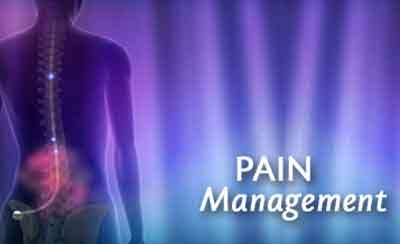- Home
- Editorial
- News
- Practice Guidelines
- Anesthesiology Guidelines
- Cancer Guidelines
- Cardiac Sciences Guidelines
- Critical Care Guidelines
- Dentistry Guidelines
- Dermatology Guidelines
- Diabetes and Endo Guidelines
- Diagnostics Guidelines
- ENT Guidelines
- Featured Practice Guidelines
- Gastroenterology Guidelines
- Geriatrics Guidelines
- Medicine Guidelines
- Nephrology Guidelines
- Neurosciences Guidelines
- Obs and Gynae Guidelines
- Ophthalmology Guidelines
- Orthopaedics Guidelines
- Paediatrics Guidelines
- Psychiatry Guidelines
- Pulmonology Guidelines
- Radiology Guidelines
- Surgery Guidelines
- Urology Guidelines
Pain management for blunt thoracic trauma: Guideline

Pain management, pain medicine, pain control or algiatry, is a branch of medicine employing an interdisciplinary approach for easing the suffering and improving the quality of life of those living with chronic pain. The typical pain management team includes medical practitioners, pharmacists, clinical psychologists, physiotherapists, occupational therapists, physician assistants, nurse practitioners, and clinical nurse specialists. The team may also include other mental health specialists and massage therapists. Pain sometimes resolves promptly once the underlying trauma or pathology has healed, and is treated by one practitioner, with drugs such as analgesics and (occasionally) anxiolytics. Effective management of chronic (long-term) pain, however, frequently requires the coordinated efforts of the management team.
In November 2016, Eastern Association for the Surgery of Trauma and Trauma Anesthesiology Society issued guidelines on Pain management for blunt thoracic trauma:Following are the major recommendations :
Question 1
In adult patients with blunt thoracic trauma (P), does epidural analgesia (I) versus nonregional modalities of pain control (C) (i.e., intravenous or enteral analgesics such as opioids, acetaminophen, nonsteroidal anti-inflammatory drugs [NSAIDs]) improve analgesia, decrease pulmonary complications and need for mechanical ventilation, shorten length of stay, and/or decrease mortality (O)?
Recommendation
In adult patients with blunt thoracic trauma, the guideline authors conditionally recommend epidural analgesia over nonregional modalities of pain control (i.e., intravenous or enteral analgesics such as opioids, acetaminophen, NSAIDs) for the treatment of pain. This recommendation is based on very low-quality evidence but places a high value on patient preferences for analgesia. If certain confounders (or effect modifiers) such as age, number of rib fractures, or severity of injury are considered, a stronger positive magnitude of effect may be observed for certain outcomes of interest.
PICO Question 2
In adult patients with blunt thoracic trauma (P), does paravertebral block (I) versus nonregional modalities of pain control (C) (i.e., intravenous or enteral analgesics such as opioids, acetaminophen, NSAIDs) improve analgesia, decrease pulmonary complications and need for mechanical ventilation, shorten length of stay, and/or decrease mortality (O)?
Recommendation
It is important to note that paravertebral block had equivalent pain control compared with epidural analgesia and provided significant pain relief compared with baseline. While desirable consequences probably outweigh undesirable consequences, because of the lack of studies comparing paravertebral block to nonregional pain control modalities, the guideline authors are unable to make a recommendation regarding the use of paravertebral blocks.
PICO Question 3
In adult patients with blunt thoracic trauma (P), does continuous intrapleural infusions of local anesthetics (I) versus other regional modalities of pain control (C) (i.e., epidural or paravertebral nerve blocks) improve analgesia, decrease pulmonary complications and need for mechanical ventilation, shorten length of stay, and/or decrease mortality (O)?
Recommendation
There is limited available literature regarding intrapleural analgesia for blunt thoracic trauma. The few studies that were identified were of very poor methodological quality. Because of insufficient evidence, the guideline authors are unable to make a recommendation.
PICO Question 4
In adult patients with blunt thoracic trauma (P), does multimodal analgesia (I) (i.e., use of different classes of analgesics, including combinations of opioids with other agents such as NSAIDs, pregabalin/gabapentin, acetaminophen) compared with opioids alone (C) improve analgesia, decrease pulmonary complications and need for mechanical ventilation, shorten length of stay, and/or decrease mortality (O)?
Recommendation
Although the quality and quantity of evidence for the use of multimodal analgesia in adult patients with blunt thoracic trauma are very limited, the guideline authors conditionally recommend this modality. This recommendation is based on very low-quality evidence but places a high value on patient preferences for analgesia. There is some indirect evidence that multiple analgesic modalities (i.e., transdermal fentanyl, NSAIDs), when combined, decrease pain in patients with blunt thoracic trauma. Use of alternative agents for patients with refractory pain is consistent with the clinical experience of the group, as patients often seek alternatives when a standard sole opioid regimen fails. Moreover, standard sole opioid regimens are often associated with adverse effects, especially as doses are escalated, thus requiring consideration for additional nonopioid analgesics.
PICO Question 5
In adult patients with blunt thoracic trauma (P), does continuous intercostal infusions of local anesthetics (I) versus nonregional modalities of pain control (C) (i.e., intravenous or enteral analgesics such as opioids, acetaminophen, NSAIDs) improve analgesia, decrease pulmonary complications and need for mechanical ventilation, shorten length of stay, and/or decrease mortality (O)?
Recommendation
Because of the lack of studies that fulfilled the inclusion criteria, no evidence profile was created. Because of insufficient evidence, the guideline authors are unable to make a recommendation.

Disclaimer: This site is primarily intended for healthcare professionals. Any content/information on this website does not replace the advice of medical and/or health professionals and should not be construed as medical/diagnostic advice/endorsement or prescription. Use of this site is subject to our terms of use, privacy policy, advertisement policy. © 2020 Minerva Medical Treatment Pvt Ltd